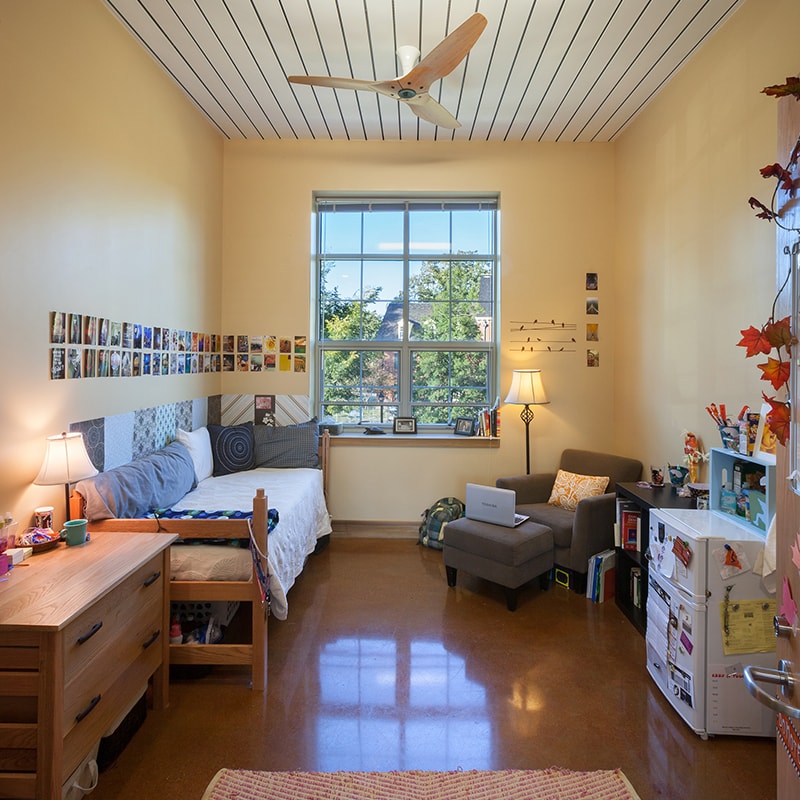Five Trends Reimagining Student Living on College Campuses

Wednesday, September 1, 2021
The era of crammed, utilitarian student living spaces is long gone. Today, student housing is a huge draw for many universities. Understanding the competitive marketplace for student housing is key to developing facilities that will help in student attraction and retention. The College Board reports that around 28% of full-time undergraduates taking courses in classroom settings live on campus while a similar share live with their family. The rest live in other off campus arrangements. Bettering student living accommodations can be a great step forward in encouraging undergraduates to live on campus. Additionally, offering prospective and current students living spaces that accommodate the modern college student’s lifestyle is important to increase student comfort, promote academic success, and build community on campus.
Our design experts have synthesized some of the major trends in student housing today.
- Health and wellness. Programs that support students’ mental and physical well-being are highly sought-after amenities for prospective and current students, especially in the wake of the COVID-19 pandemic. In the midst of uncertainty, students desire a level of comfort and safety in their home-away-from-home. Air purification systems, food delivery lockers, keyless entry, and added sanitation measures are practical components to incorporate in a new or renovated student housing complex. Additionally, student housing design can also help address the ongoing mental health crisis experienced by college-aged students across the United States, which has resulted in increased suicide rates, declining academic success, and increased tendency to drop out of college. Living spaces can play an integral role in supporting the mental health of students through small fitness centers, multipurpose rooms for yoga, meditation, and dance, and demonstration kitchens that encourage self-sufficiency and healthy living. Another mood-bosting feature of a student living facility is to create welcoming outdoor spaces, whether it’s an outdoor classroom or lively courtyard, like in University of Tulsa’s Hardesty Hall.
- Sustainable design. Many students want to be involved and informed when it comes to their use of natural resources on campus. Sustainable design elements not only preserve the environment, they also bring about cost-savings and educational opportunities. Practical expressions of sustainable design include the use of energy-smart appliances, LED lighting, passive lighting, reclaimed wood, solar panels, rain barrels, gardens, composting, and low-flow showerheads, among other features. Students who live in Deep Green Residence Hall at Berea College have a unique opportunity to take ownership of their sustainable habits and participate in active learning about environmental consciousness. Berea College is using the facility’s LEED Platinum Certification and Living Building Challenge Petal Certification as a teaching and learning tools for students. Students are invited to make conscious choices about their energy usage, and the results of their choices can be seen and measured in their online sustainability dashboard.
- Learning communities. Learning communities, or groups of students who take a common set of courses or share a common academic experience, are a growing trend for two main reasons. They offer a well-defined path to academic success, and they also can create the conditions of a small college experience at larger institutions. These programs positively impact student retention at all levels by offering peer groups for first- and second-year students and by providing opportunities for leadership skills to emerge in upper-class students. Saint Louis University’s Grand Hall is designed to support a variety of student Learning Communities. Integrated academic and student life opportunities exist through three Learning Communities: Diversity and Global Citizenship; Engineering and Innovation; and Ethical Leaders in Business. Each has its own dedicated residential floor and specialized learning commons to support academic goals.
- Balance of privacy and collaboration. The transition to college expectations and on-campus living can be a challenge for many students. Creating living environments that provide ample spaces that give students greater choice over when to socialize and when to study is key. Suite living is now the norm in newly constructed student living complexes. Having bedrooms and bathrooms in close proximity and reducing the number of students sharing a room and bathroom often increases student comfort. At the same time, students still desire spaces for collaborative work and community-building. For example, Saint Louis University’s Spring Residence Hall features single and double suite-style rooms, yet all floors are designed to support learning and collaboration, whether in the lounges at the end of each floor, in classrooms or in designated study rooms. Furniture selections were tailored to each space to support a range of small- and large-group activities.
- Accessibility and inclusivity. Accessibility and inclusivity are at the forefront of our architectural design decisions for all of our clients. These terms are multi-faceted in their meaning. Designing with accessibility in mind means creating environments where students with physical differences can participate in the independence of college student life. Accessibility in a different sense may involve technological upgrades that ensure all students have access to online course websites from their housing. Inclusivity in student housing design may take the form of amenities like gender neutral bathrooms, a Wudu Islamic ritual bath, or a lactation room for parents. To read more about our firm’s commitment to accessibility and inclusivity, read the article Inspiring a Spirit of Inclusivity in Design.
Hastings+Chivetta strives to design student living facilities that support an institutional mission and empower students to enhance their campus community. Our experience with a variety of collegiate building types and across markets helps inform our design and results in better outcomes for our collegiate clients. At H+C, we form strong partnerships with each of our clients, which creates educational and living environments that support student and institutional success.
To learn more about how we integrate existing and emerging student life trends into timeless architectural design, contact Erik Kocher at [email protected] or (314) 529-4004.